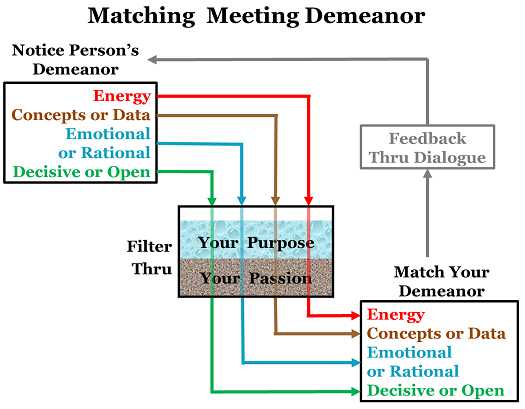When you walk in the room, who shows up for Read more →
Leadership Tools: Matching Meeting Demeanor
Posted Wednesday, March 6, 2013Allen Slade
Leaders need a toolbox full of tools for task leadership (budgeting, scheduling, goal setting, task execution) and relationship building(communication, decision making techniques, empathy). To use these leadership tools well, you need to diagnose the situation before you pick your tool.
A coaching client asked me “How should I act?” in an important meeting. I suggested matching his confidence to his competence and matching his demeanor to the other person. Let’s look at how “demeanor matching” works.
Often, leaders are called upon to persuade someone to take action. You might be planning with your boss, problem solving with an employee, trying to close a sale or interviewing for a job. It’s important to focus on the content of the meeting, but your influence will be determined by the tone of the meeting. How do you get your demeanor right?
Consider four dimension of meeting demeanor:
- High energy vs. low energy.
- Concrete data vs. abstract concepts.
- Rational persuasion vs. emotional persuasion.
- Decisive choices vs. option multiplying.
If two people are badly mismatched on any of these dimensions, the meeting will not go well.
We have all been held hostage in meetings. The other person is not on your wavelength and they are clueless about their lack of influence. They are high energy while you are drifting off. Maybe they offer abstract concepts when you need hard data. Or they make an emotional appeal when you want a rational argument. They push for decisive action when you want to keep your options open.
To avoid holding others hostage in a pointless meeting, don’t be tone deaf. Start by noticing the other person’s demeanor, then decide how your meeting demeanor needs to adjust.
Energy. If they have little energy for this topic, don’t try to bulldoze them. Take a low key approach. Pause, contemplate, listen even more than usual. But if they have high energy, ramp up your excitement to match.
If your purpose is to pursuade them, you may have to go against your native personality. Extroverts may have to calm down. Introverts may need to get fired up.
Concepts/data. If their conversation centers around concepts, principles, precedents, fairness – respond in kind. If they ask for data, proof, evidence, case studies, give them the numbers and facts they need.
Once again, you may be more conceptual or more data oriented, but don’t let that undermine your effectiveness if the other person is on a different wavelength.
Emotional arguments or rational arguments. Listen and observe. If they say or act in a way that suggests they want to approach this topic through an emotional lens, paint your argument with the colors of feeling. If they want to argue, respond with logic.
The “emotional intelligence” industry is built on the failings of leaders who think it is irrational to be emotional. You can also fail with feelings when the other person wants logic. Either way, if your purpose is to persuade, you may have to step outside your native logic to match their meeting demeanor.
Decisive or open. Sometimes, the other person wants to decide now. Other times, they want more options, more evidence or more people involved.
If you are naturally decisive but they want more time, you may need to practice patience. If you tend to keep your options open but the other person expresses impatience, you may need to work toward a “best guess” decision.
Bottom line: Effective leaders are versatile in their meeting demeanor. They use high energy or calmness, concepts or data, feelings or logic, decisiveness or patience, as needed to fulfill their purpose in the meeting.
In your next meeting, try noticing the demeanor of the other person. Then notice your own demeanor. Adjust as needed to be at your most influential.


